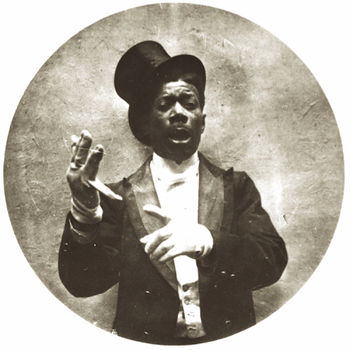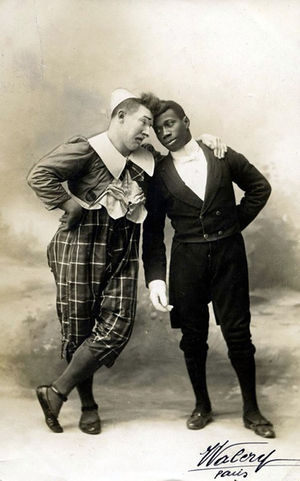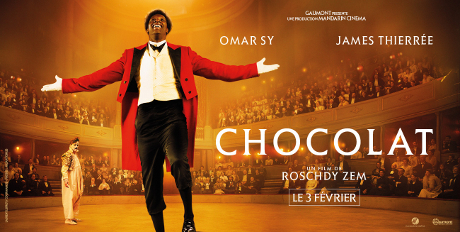Chocolat was the artistic name of Rafael Padilla, who at the age of 28 had already spent a decade dedicating himself to the clown trade in the most important shows in Paris, and rubbed shoulders with the most important characters in the city.
Born in Cuba to African slaves, Rafael Padilla battled racism to become the toast of bourgeois Paris, feted by the rich and powerful for his performances as “Chocolat the clown,” France’s first black celebrity.
He claimed to have no memory of his biological parents and was picked up and raised by a poor black woman in the suburbs of Havana, during the Ten Years’ War. When Rafael was still a child, he was sold to a Spanish businessman, Patricio Castaño Capetillo, who took him to his family’s home in the town of Sopuerta (Vizcaya) in northern Spain.
Cuba had banned the slave trade in 1862, and under international law Rafael technically was a free man at the time he set foot on European soil, however Castaños treated him like a slave. Castaños, like many Spaniards with colonial connections, was anti-abolitionist and dodged the law by registering Rafael as a servant, being the only black person in the town, and not mistreated by the Castaños family and by the villagers. They made him sleep in the stables, and he received no formal education.
Counting on 15 years of age and seeing the opportunity, Rafael fled from his exploiter and worked in the quarries of the Basque Country, and lived in Bilbao, where he met Tony Grice, an English clown, who hired him as an assistant and domestic servant, but who incorporated him into his performances, which he did not like and for which he left Grice, returning only when forced to find no occupation.
But with his mentor he became one of the great circus stars and met Marie Hecquet, with whom he married in 1895 all in a great scandal for interracial marriage and divorced Marie to go with him. Around the same time, Chocolat received the offer to make an artistic pair with another of the great clowns of that time: George Foottit
The triumph of the couple was based on the continuous teasing and abuse that the white clown made the black clown. Chocolat was aware that the color of her skin was a handicap for many things, but in that aspect it gave her a job that she liked, enjoyed and gave to live comfortably with her family.
Around 1910 a part of the society began to see how the treatment that Chocolat received on stage, seeing it as abusive and in bad taste, ended the career of the artist, as the businessmen stopped hiring him, fearing be accused of racism.
Suddenly all the evils fell to him, he was left without work, he was completely ruined, he dedicated himself to drinking and fell into a deep depression caused by the death by tuberculosis of his daughter. At 49 he died alone in a hotel room in Bordeaux.
There is a painting by the painter Toulouse-Lautrec and entitled “Chocolat dansant dans un bar”, where he somehow immortalized Chocolat dancing in the Irish and American Bar in Paris, the favorite place of Bohemia in those years.
But there is also reference to the character that revolutionized the Parisian scene a century ago when filming a movie called Chocolat.
Almost a century after he was laid to rest in a mass grave in the French capital, his largely forgotten story is being told in the North American premiere on Monday of Roschdy Zem’s “Chocolat.”
It is a bold choice to open COLCOA, the world’s largest festival of French film, as it challenges audiences to consider whether Hollywood’s notorious diversity problem is also an issue in France.
PERSONAJES CUBANOS: “EL PAYASO CHOCOLATE”, ADMIRADO COMO ARTISTA EN PARÍS.
Chocolat era el nombre artístico de Rafael Padilla, que con 28 años de edad ya llevaba una década dedicándose al oficio de payaso en los espectáculos más importantes de París, y se codeaba con los personajes más importantes de la ciudad.
Nacido en Cuba de esclavos africanos, Rafael Padilla luchó contra el racismo para convertirse en el brindis del París burgués, agasajado por los ricos y poderosos por sus actuaciones como “Chocolat the Clown”, la primera celebridad negra de Francia.
Decía no tener ningún recuerdo de sus padres biológicos y fue recogido y criado por una mujer negra pobre en los suburbios de La Habana, durante la Guerra de los Diez Años. Cuando Rafael era todavía un niño, fue vendido a un empresario español, Patricio Castaño Capetillo, el que lo llevó a la casa de su familia en el pueblo de Sopuerta (Vizcaya) en el norte de España.
Cuba había prohibido la trata de esclavos en 1862, y bajo la ley internacional Rafael técnicamente era un hombre libre en el momento en el que pusiera pie en tierra europea, sin embargo Castaños le trató como a un esclavo. Castaños, como muchos españoles con conexiones coloniales, era anti-abolicionistas y esquivó la ley registrando a Rafael como sirviente, siendo la única persona negra en el pueblo, y no era maltratado por la familia Castaños y por los habitantes del pueblo. Le hacían dormir en los establos, y no recibió ninguna educación formal.
Contando con 15 años de edad y viendo la oportunidad, Rafael huyó de su explotador y trabajó en las canteras del País Vasco, y vivió en Bilbao, donde conoció a Tony Grice, un payaso inglés, quien le contrató como ayudante y criado doméstico, pero que lo incorporó a sus actuaciones, cosa que no le gustaba y por la que abandonó a Grice, regresando solo al verse obligado por no encontrar ocupación.
Pero junto a su mentor se convirtió en una de las grandes estrellas de circo y conoció a Marie Hecquet, con quien se casó en 1895 todo dentro de un fenomenal escándalo por el matrimonio interracial y por haberse divorciado Marie para irse con él. Por esa misma época Chocolat recibió la oferta hacer pareja artística con otro de los grandes payasos de aquellos tiempos: George Foottit
El triunfo de la pareja se basaba en las continuas burlas y maltratos que el payaso blanco hacía al payaso negro. Chocolat era consciente que el color de su piel era un hándicap para muchas cosas, pero en ese aspecto le proporcionaba un trabajo que le gustaba, con el que disfrutaba y que le daba para vivir holgadamente con su familia.
Alrededor de 1910 una parte de la sociedad comenzó a ver como vejatorio el trato que recibía Chocolat en el escenario, viéndolo como abusivo y de mal gusto y esto acabó con la carrera del artista, ya que los empresarios dejaron de contratarlo, ante el temor de ser acusados de racistas.
De repente le cayeron juntos todos los males, se quedó sin trabajo, se arruinó por completo, se dedicó a la bebida y cayó en una profunda depresión causada por la muerte por tuberculosis de su hija. A los 49 años falleció solo en la habitación de un hotel en Burdeos.
Hay un cuadro del pintor Toulouse-Lautrec y que titulaba “Chocolat dansant dans un bar”, donde de alguna forma inmortalizó a Chocolat bailando en el Irish and American Bar de París, sitio preferido de la bohemia en esos años.
Pero también se hace referencia al personaje que revolucionó la escena parisina de hace un siglo al filmarse una película llamada Chocolat.
ero también se hace referencia al personaje que revolucionó la escena parisina hace un siglo cuando filmaba una película llamada Chocolat.
Casi un siglo después de que fue sepultado en una fosa común en la capital francesa, su narración en gran parte olvidada se narra en el estreno norteamericano el lunes de “Chocolat” de Roschdy Zem.
Es una elección audaz para abrir COLCOA, el festival de cine francés más grande del mundo, ya que desafía a las audiencias a considerar si el notorio problema de diversidad de Hollywood también es un problema en Francia.









